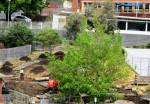Goulburn Street Primary School
Forest Road, West Hobart
Site for redevelopment
Yellowland refers to an area of land that is situated next to the tennis court and below the recently completed Phoenix building. It has street frontage onto Goulburn Street, but is on a raised site so there is no direct access from the street to this area. The site is approximately 500m2 in area and has a northerly aspect. The site is largely under developed and at present is generally out of bounds for students during school hours.
Design Brief
To redevelop an unused section of the school grounds into an outdoor Learning Landscape that will celebrate our natural environment. The space will encourage and enable scientific exploration in a natural setting by class groups, particularly to support teaching and learning of Science through investigation of living things including animals, plants and micro-organisms.
Native flora, including grasses commonly used in Tasmanian aboriginal weaving, recycled and natural building materials are the preferred palette, to create a learning space that will incorporate the cross-curricular priorities of Aboriginal Culture and Sustainability from the Australian Curriculum.
The space is to be inspiring and unfolding, aimed to harness a sense of adventure and discovery, and could incorporate sculpture/artwork and student projects.
The following components have been identified as possible elements:
– A pathway from the tennis court back gate to the pathway near the Phoenix building
– Natural seating-space for a class group to gather
– Native vegetation including low bushes & trees, grasses for weaving
– Mural perhaps on back concrete retaining wall
– Some kind of wandering “mazelike” pathways
– Dry creek bed with pebbles and stones
– Reflective surfaces (mirrors) and musical sculptures (perhaps around the ideas of sun, moon, seasons, native animals)
– Representations of native Australian animals through sculpture or 2D artwork
– Reusing or recycling of everyday materials
– Fallen logs or rocks for scrambling (and habitats for small creatures
– Natural water catchments
– Vertical gardens
– Storage boxes or walls
– Structure that incorporates weaving with native grasses
Design inspiration
An important consideration is the concept of an outdoor classroom that provides the space for teachers to take their class group outside – encouraging learning in a different setting, such as scientific exploration, studies of nature and use of natural materials. The project is taking cues from the Molesworth Environment Centre, Steiner play grounds and various natural play spaces. The space should unfold and encourage adventure and discovery.
Additional Considerations
Profits from the 2010 School Fair have been re-directed to help fund the project. It is envisaged that the project will also tap into the generosity and skills of parents and local businesses to partner the school in undertaking the program.
A central focus for the committee is to create a harmonious process to engage all involved through forward planning and a clear vision, throughout the different stages as the project evolves. Design is therefore integral to this process, to establish the vision in a tangible way that can be then used to harness the support and assistance of the school community.





